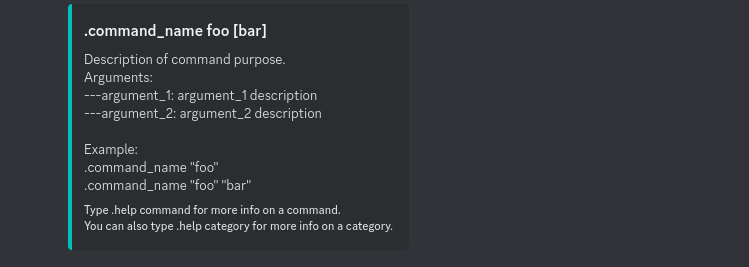-
Notifications
You must be signed in to change notification settings - Fork 19
Wall_e Discord.py Coding Tips
Please follow the format below when adding a new help message so that layout is unified across all commands
@commands.command(
brief="short help message in main help embed",
help=(
'Description of command purpose.\n'
'Arguments:\n'
'---argument_1: argument_1 description\n'
'---argument_2: argument_2 description\n\n'
'Example:\n'
'.command_name "foo"\n'
'.command_name "foo" "bar"\n\n'
),
usage='foo [bar]'
)
async def command_name(self, ctx, *args):

@commands.has_any_role("role1", "role2")
async def command_name(self, ctx, *args):OR
@commands.has_role("role1")
async def command_name(self, ctx, *args): @commands.has_guild_permissions(administrator=True, manage_roles=True) # this does an AND
async def command_name(self, ctx, *args):If the above examples don't provide a way for the sort of permission checking you are attempting, you can write your own logic using the below example
def user_has_perms(ctx):
return ctx.author.guild_permissions.administrator or ctx.author.guild_permissions.manage_roles
@commands.check(user_has_perms)
async def command_name(self, ctx, *args): @app_commands.command(name="command_name", description="command description")
@app_commands.describe(argument_name="argument description")
async def function_name(self, interaction: discord.Interaction, argument_name: str):

@app_commands.checks.has_role("role1")
async def command_name(self, interaction: discord.Interaction):OR
@app_commands.checks.has_any_role("role1", "role2")
async def command_name(self, interaction: discord.Interaction): @app_commands.checks.has_permissions(administrator=True, manage_roles=True) # this does an AND
async def command_name(self, interaction: discord.Interaction):If the above examples don't provide a way for the sort of permission checking you are attempting, you can write your own logic using the below example
def user_permission_check(interaction: discord.Interaction) -> bool:
return interaction.user.guild_permissions.administrator or interaction.user.guild_permissions.manage_roles
@app_commands.check(user_permission_check)
async def command_name(self, interaction: discord.Interaction):slash commands introduced the ability to provide users with a menu of options they can choose from for a command's argument. You can see this in action with the /iam command on the CSSS Discord guild
OR
@app_commands.autocomplete(argument_name=[
# list of app_commands.Choice items
# choice object example: app_commands.Choice(name="string that will be shown in discord, value="value passed to the command")
])
async def command_name(self, interaction: discord.Interaction, argument_name: str):If the options you want to provide need to be pulled from discord in some way, you can extend the functionality of the autocomplete function like this:
async def argument_options(interaction: discord.Interaction, current: str) -> List[app_commands.Choice[str]]:
// create choice object using data pulled from interaction and using "current" as a filter to pass the objects through
return [choice]
@app_commands.autocomplete(argument_name=argument_options)
async def command_name(self, interaction: discord.Interaction, argument_name: str):General layout to follow when adding a new cog class
class NewCog(commands.Cog):
def __init__(self, bot, config, bot_channel_manager):
log_info = Loggers.get_logger(logger_name="NewCog")
self.logger = log_info[0]
self.debug_log_file_absolute_path = log_info[1]
self.error_log_file_absolute_path = log_info[2]
self.logger.info("[NewCog __init__()] initializing NewCog")
self.bot = bot
self.config = config
self.guild: discord.Guild = None
self.bot_channel_manager = bot_channel_manager
@commands.Cog.listener(name="on_ready")
async def get_guild(self):
self.guild = self.bot.guilds[0]
@commands.Cog.listener(name="on_ready")
async def upload_debug_logs(self):
if self.config.get_config_value('basic_config', 'ENVIRONMENT') != 'TEST':
while self.guild is None:
await asyncio.sleep(2)
await start_file_uploading(
self.logger, self.guild, self.bot, self.config, self.debug_log_file_absolute_path, "new_cog_debug"
)
@commands.Cog.listener(name="on_ready")
async def upload_error_logs(self):
if self.config.get_config_value('basic_config', 'ENVIRONMENT') != 'TEST':
while self.guild is None:
await asyncio.sleep(2)
await start_file_uploading(
self.logger, self.guild, self.bot, self.config, self.error_log_file_absolute_path, "new_cog_error"
)
# specify any new command to listeners belowAdd the cog to the .ini files in the https://github.com/CSSS/wall_e/tree/master/wall_e/utilities/config folder
If you need to add any logic to the cog class that the bot will execute as soon as the on_ready signal has been received [when its logged into the discord guild], use the below template
@commands.Cog.listener(name='on_ready')
async def function_name(self):
while self.guild is None:
await asyncio.sleep(2)
# function logicYou can see the list of discord events that a discord bot can listen for here
the above documentation was adapted from